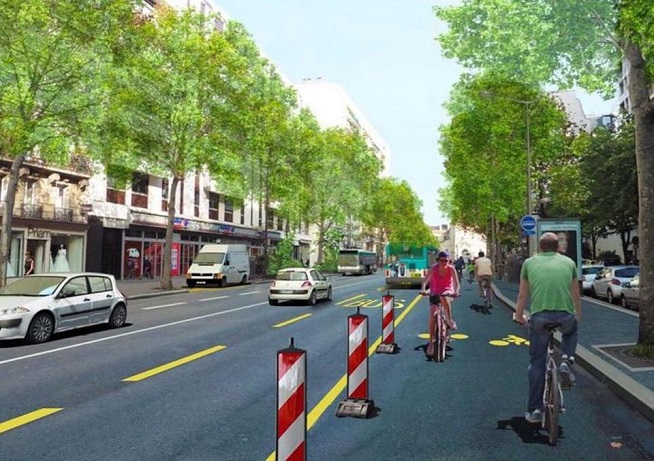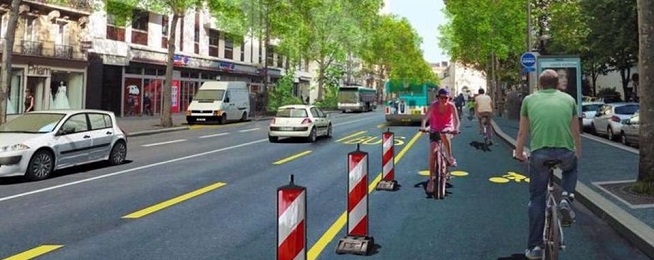With cities around the world opening streets so their citizens can get their physical activity while maintaining physical distancing, the lack of action in Australia is seeing us get overtaken by other cities in the liveable stakes.
We’ve had a look at 2019’s most liveable cities and what they’ve done to make bike riding easier and then re-ranked the top 10.
The new rankings see Melbourne fall from two to nine and Sydney from three to eight.
Our friends across the ditch in Auckland have rocketed up to number two, while Paris has taken out top spot.
We’re not proud to have to rank our own cities lowly, so we’ve also got some ideas to get back to the top.
The world’s most liveable cities re-ranked
1. Paris, France – was 25 in 2019
Paris slid down to number 25 on the list of liveable cities list in 2019 because of its yellow vest protests, but in our coronavirus response list it’s at number one after deciding to set up a whopping 650 kilometres of pop-up bike lanes in the city.
The corona cycleways will be installed in place of on-street car parking—72% of parking spots will be removed—and divided from other traffic with reflective sticks, something people who ride on Melbourne’s Albert Street will be familiar with.

2. Auckland, New Zealand – 12 in 2019
Auckland was listed at number eight in the 2017 liveable cities ranking. In 2018 and 2019 the city was listed at 12, but now it’s back after some excellent work to help people stay active during coronavirus.
The city is putting in more than 22 kilometres of pop-up bike riding and walking lanes to help people maintain physical distancing while getting important exercise.
Several roads in central Auckland will have work done, including Tamaki Drive, a coastal road that follows Waitemata Harbour, where car parking will be removed and bike lanes installed.

3. Vienna, Austria – was 1 in 2019
The City of Vienna has opened many streets for people and reduced access for cars. Streets with narrow footpaths and no nearby parks or green spaces were turned into temporary encounter zones where people can use the road and exercise while keeping distance from others.
4. Calgary, Canada – was 5 in 2019
Calgary have been closing some traffic lanes and roads to cars to let people walk, ride, run and rollerblade with ease and space.
The City of Calgary is not publicising which roads have been closed so that people don’t rush to them, but they say they are reviewing every request for roads to be transformed. As the weather warms and snow melts it is expected that more people will want to exercise outside and that more closures will be made.
5. Vancouver, Canada – was 6 in 2019
The City of Vancouver created a physical activity zone in Stanley Park by closing the park to all motor vehicles as well closing lanes on Beach Avenue, the road that leads to Stanley Park.
6. Copenhagen, Denmark – was 9 in 2019
Copenhagen does not seem to have made any specific changes to road space in the city, but with such an extensive network of wide, protected bike lanes, perhaps there isn’t as much need as other cities.
They were able to lean on the existing network and recommended that people ride a bike instead of taking public transport when coronavirus became a serious issue in March.
7. Toronto, Canada – was equal 7 in 2019
Toronto has begun reserving road space next to footpaths for pedestrians, however rather than helping people ride and walk, it is being done to help people maintain physical distancing while queuing for shops.
The city’s chief medical officer said they will not recommend creating extra space for exercise because they are focusing on encouraging people stay home.
8. Sydney, Australia – was 3 in 2019
Clover Moore, Lord Mayor of Sydney has said that she would like to reclaim some space from cars and create temporary changes to streets including reducing some speed limits to 30km/h and using lane dividers on roads. The NSW government said they will work with councils on reconfiguring public spaces, but so far no changes have been made in NSW.
9. Melbourne, Australia – was 2 in 2019
The City of Melbourne said they would like to fast track the building of protected bike lanes highlighted in their 2030 transport plan – however this commitment had already been made prior to COVID-19 as a climate emergency response. There has been no action by the Victorian state government to create more space for bike riding and physical activity.

10. Tokyo, Japan – was equal 7 in 2019
Tokyo doesn’t seem to have made any changes to road space to help people cycle and exercise.
Tokyo is an unusual city for bike riding – it has barely any bike lanes but heaps of riders. Approximately 16 per cent of trips are made by bike and the number of women who ride is high.
They were able to lean on the existing network and recommended that people ride a bike instead of taking public transport when coronavirus became a serious issue in March.
The sliders
Osaka, Japan – was 4 in 2019
Osaka has not made any changes to roads and public places to make bike riding easier. It would be nice to see something done in what is generally regarded as good Japanese bike city.
Adelaide, Australia – was 10 in 2019
No changes have been made in Adelaide to give more road space to people on bikes, and despite call from local group Bike SA, it doesn't seem like it is being considered.
Help us climb the ladder
There is of course time for Australian cities to take action and get into the top 5.
Bicycle Network is campaigning for local and state governments to create more safe places to ride by installing pop-up bike lanes, reducing speed limits on some streets and prioritising bike riding and walking.
You can join our More space for bikes campaign by contacting your local MP and asking them to action.
See our campaign

